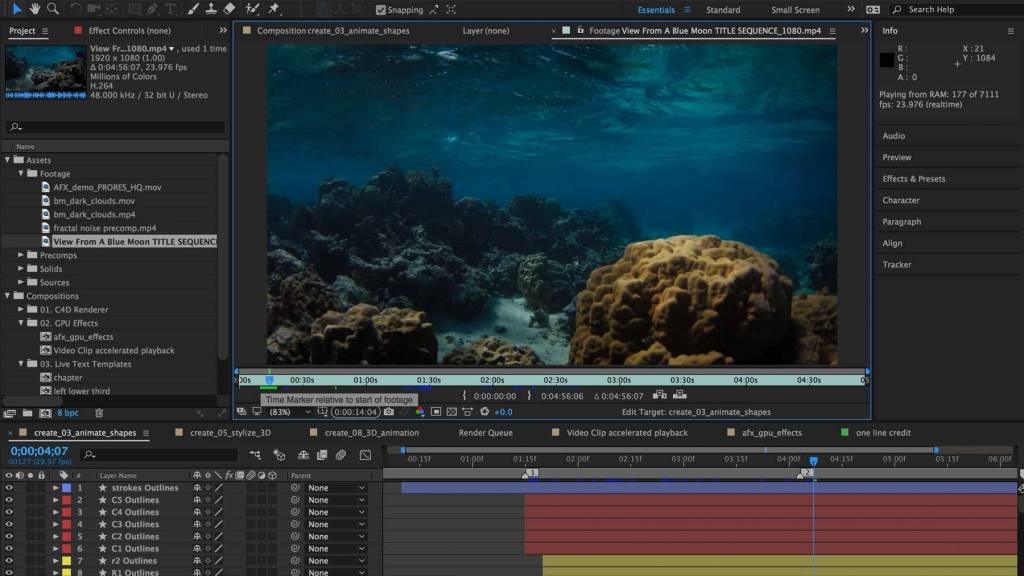

- #ADOBE AFTER EFFECTS VIDEO EDITING TUTORIALS PDF 1080P#
- #ADOBE AFTER EFFECTS VIDEO EDITING TUTORIALS PDF PRO#
- #ADOBE AFTER EFFECTS VIDEO EDITING TUTORIALS PDF SOFTWARE#
- #ADOBE AFTER EFFECTS VIDEO EDITING TUTORIALS PDF PROFESSIONAL#

Camera tracking and motion stabilization Creating 3D animations and environments Module 7: 3D Animation and Camera Tracking Understanding color spaces and color correction Advanced compositing and blending modes Masking techniques for selective adjustments Working with alpha channels and transparency Using expressions to automate animations Introduction to expressions and scripting Using the graph editor for precise control

Understanding keyframes and interpolation Working with presets and animation presets Using adjustment layers and track mattes Using parenting and null objects for complex animations Applying transformations and motion paths Working with shape layers and vector graphics Module 1: Introduction to Adobe After Effects CS6 Export your projects for different platforms and formats. Utilize various plugins and scripts to enhance your workflow.Ĩ. Work with 3D space and create 3D animations.ħ. Apply advanced techniques for color correction, tracking, and rotoscoping.Ħ. Composite multiple layers and footage to create seamless visual effects.ĥ. Use keyframes and expressions to control motion and behaviors.Ĥ. Create and manipulate various types of animations and effects.ģ. Understand the fundamentals of Adobe After Effects CS6 and its interface.Ģ. Upon completion of this course, you will be able to:ġ.
#ADOBE AFTER EFFECTS VIDEO EDITING TUTORIALS PDF SOFTWARE#
Each module will focus on specific aspects of Adobe After Effects CS6, allowing you to master the software step by step. The course is divided into 10 modules, with a total duration of 40 hours.
#ADOBE AFTER EFFECTS VIDEO EDITING TUTORIALS PDF PROFESSIONAL#
Whether you are a beginner with no prior experience or an intermediate user looking to enhance your skills, this course will take you from a novice to a professional level. This course is designed to provide comprehensive training in Adobe After Effects CS6, one of the leading software programs for creating motion graphics and visual effects.
#ADOBE AFTER EFFECTS VIDEO EDITING TUTORIALS PDF PRO#
Click on the green play button to begin the export.IT & Software Adobe After Effects CS6: Complete Course from Novice to Pro.A dialogue box will appear on your screen and prompt you to select a location to save your rendered composition. In the queue, locate “Output To” and click on the linked text next to the left of this section.Drag this preset from the browser onto the file in the “Adobe Media Encoder Queue.” Find the “Preset Browser.” Select the format for your composition.Select “Export” followed by “Add to Adobe Media Encoder Queue.” You may also select “Composition” followed by “Add to Adobe Media Encoder Queue” or drag the file directly into the “Adobe Media Encoder Queue” tab. Click on “File” at the top of the window.While your project is rendering in the Media Encoder, you may continue to work in Adobe After Effects. The Media Encoder will also export files that are compatible with specific web platforms. The Adobe Media Encoder will produce a compressed version of your composition. X Research source X Research sourceĮxport your composition to Adobe Media Encoder. Set the “Duration” to the required length for your composition. “Duration” refers to the total length of the project, from start to end. In the second row, find “Start Timecode” and “Duration.” Leave the “Start Timecode” at 0.It's always a good idea to create effects in 8K for future-proofing.
#ADOBE AFTER EFFECTS VIDEO EDITING TUTORIALS PDF 1080P#
Select "UHD 8K 23.976", which is four times the resolution of 1080p HD with 23.976 frames per second.

The menu is divided up into four sections, respectively: Web settings, standard definition broadcast settings (NTSC and PAL), HD settings (the most used), and film settings. Don't know what resolution to choose? Locate “Preset” and click on the drop-down menu.Every time you create a new composition, a “Composition Settings” window will appear on your screen. If you already have the program open, you may either click on the “Composition” tab and select “New Composition” or use the keyboard shortcut Ctrl+ N. At the Welcome screen, locate and click on the New Composition button in the right column. Projects in Adobe After Effects are called compositions, or comps.


 0 kommentar(er)
0 kommentar(er)
